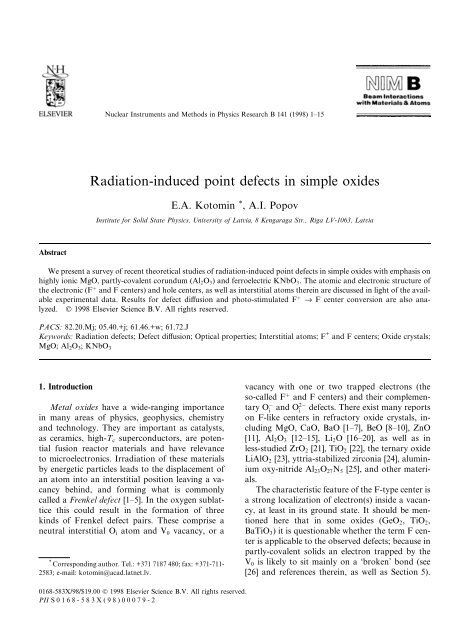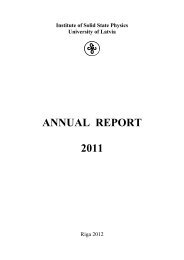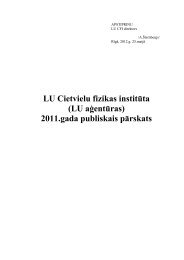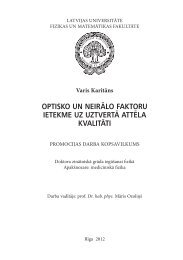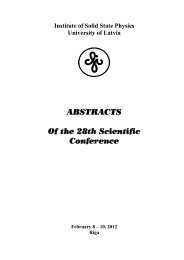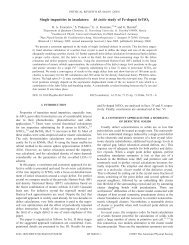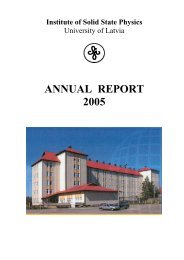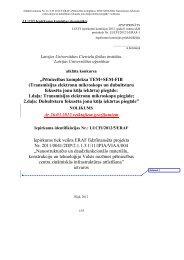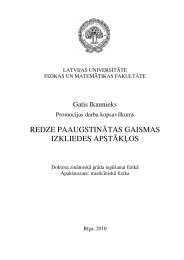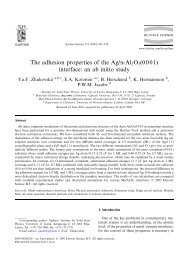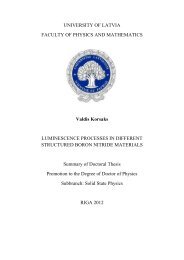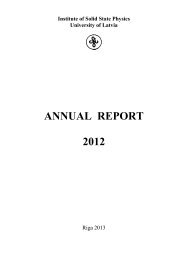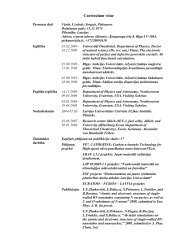Radiation-induced point defects in simple oxides - Institute of Solid ...
Radiation-induced point defects in simple oxides - Institute of Solid ...
Radiation-induced point defects in simple oxides - Institute of Solid ...
You also want an ePaper? Increase the reach of your titles
YUMPU automatically turns print PDFs into web optimized ePapers that Google loves.
Nuclear Instruments and Methods <strong>in</strong> Physics Research B 141 (1998) 1±15<strong>Radiation</strong>-<strong><strong>in</strong>duced</strong> <strong>po<strong>in</strong>t</strong> <strong>defects</strong> <strong>in</strong> <strong>simple</strong> <strong>oxides</strong>E.A. Kotom<strong>in</strong> * , A.I. Popov<strong>Institute</strong> for <strong>Solid</strong> State Physics, University <strong>of</strong> Latvia, 8 Kengaraga Str., Riga LV-1063, LatviaAbstractWe present a survey <strong>of</strong> recent theoretical studies <strong>of</strong> radiation-<strong><strong>in</strong>duced</strong> <strong>po<strong>in</strong>t</strong> <strong>defects</strong> <strong>in</strong> <strong>simple</strong> <strong>oxides</strong> with emphasis onhighly ionic MgO, partly-covalent corundum (Al 2 O 3 ) and ferroelectric KNbO 3 . The atomic and electronic structure <strong>of</strong>the electronic (F ‡ and F centers) and hole centers, as well as <strong>in</strong>terstitial atoms there<strong>in</strong> are discussed <strong>in</strong> light <strong>of</strong> the availableexperimental data. Results for defect di€usion and photo-stimulated F ‡ ® F center conversion are also analyzed.Ó 1998 Elsevier Science B.V. All rights reserved.PACS: 82.20.Mj; 05.40.+j; 61.46.+w; 61.72.JKeywords: <strong>Radiation</strong> <strong>defects</strong>; Defect di€usion; Optical properties; Interstitial atoms; F + and F centers; Oxide crystals;MgO; Al 2 O 3 ; KNbO 31. IntroductionMetal <strong>oxides</strong> have a wide-rang<strong>in</strong>g importance<strong>in</strong> many areas <strong>of</strong> physics, geophysics, chemistryand technology. They are important as catalysts,as ceramics, high-T c superconductors, are potentialfusion reactor materials and have relevanceto microelectronics. Irradiation <strong>of</strong> these materialsby energetic particles leads to the displacement <strong>of</strong>an atom <strong>in</strong>to an <strong>in</strong>terstitial position leav<strong>in</strong>g a vacancybeh<strong>in</strong>d, and form<strong>in</strong>g what is commonlycalled a Frenkel defect [1±5]. In the oxygen sublatticethis could result <strong>in</strong> the formation <strong>of</strong> threek<strong>in</strong>ds <strong>of</strong> Frenkel defect pairs. These comprise aneutral <strong>in</strong>terstitial O i atom and V 0 vacancy, or a* Correspond<strong>in</strong>g author. Tel.: +371 7187 480; fax: +371-711-2583; e-mail: kotom<strong>in</strong>@acad.latnet.lv.vacancy with one or two trapped electrons (theso-called F ‡ and F centers) and their complementaryO iand O 2i<strong>defects</strong>. There exist many reportson F-like centers <strong>in</strong> refractory oxide crystals, <strong>in</strong>clud<strong>in</strong>gMgO, CaO, BaO [1±7], BeO [8±10], ZnO[11], Al 2 O 3 [12±15], Li 2 O [16±20], as well as <strong>in</strong>less-studied ZrO 2 [21], TiO 2 [22], the ternary oxideLiAlO 2 [23], yttria-stabilized zirconia [24], alum<strong>in</strong>iumoxy-nitride Al 23 O 27 N 5 [25], and other materials.The characteristic feature <strong>of</strong> the F-type center isa strong localization <strong>of</strong> electron(s) <strong>in</strong>side a vacancy,at least <strong>in</strong> its ground state. It should be mentionedhere that <strong>in</strong> some <strong>oxides</strong> (GeO 2 , TiO 2 ,BaTiO 3 ) it is questionable whether the term F centeris applicable to the observed <strong>defects</strong>; because <strong>in</strong>partly-covalent solids an electron trapped by theV 0 is likely to sit ma<strong>in</strong>ly on a `broken' bond (see[26] and references there<strong>in</strong>, as well as Section 5).0168-583X/98/$19.00 Ó 1998 Elsevier Science B.V. All rights reserved.PII S 0 1 6 8 - 5 8 3 X ( 9 8 ) 0 0 0 7 9 - 2
2 E.A. Kotom<strong>in</strong>, A.I. Popov / Nucl. Instr. and Meth. <strong>in</strong> Phys. Res. B 141 (1998) 1±15The <strong>simple</strong>st F-aggregates are called dimers, or F 2 -centers. In the cation sublattice one expects formation<strong>of</strong> pairs compris<strong>in</strong>g <strong>in</strong>terstitial cations andcomplementary cation vacancies. The latter areknown to trap holes created under irradiationand thus readily transform <strong>in</strong>to the so-called V or V 0 centers (a cation vacancy with one and twoholes, respectively) [2,27].Formation <strong>of</strong> Frenkel <strong>defects</strong> is characterizedby their threshold energies given <strong>in</strong> Table 1. (Anotheranalysis for some <strong>oxides</strong>, SiC and diamondsee[12].) Absorption and lum<strong>in</strong>escence energiesare collected <strong>in</strong> Tables 2 and 3. Usually the F ‡ absorptionband lies on the long-wavelength side <strong>of</strong>that for the F center and its energy obeys the <strong>simple</strong>empirical (Mollwo-like) law [51]:E abs …eV† ˆ 44:4a 2 3:5a 1 ;…1†where a ˆ n 1=3 is a mean distance between two Oatoms and n their concentration <strong>in</strong> the crystal. Of awide class <strong>of</strong> b<strong>in</strong>ary and ternary <strong>oxides</strong> we will focushere on three representatives ± highly ionicTable 1Displacement energy for some oxygen compoundsMaterialDisplacement energy (eV)Metal Oxygen ReferencesAl 2 O 3 18 75 [28]70 [29]90 [30]24 79 [31]41±53 [32]53 [33]MgO 60 [34]64 [35]60 53 [36]37 55 [37]30 [39]CaO 58 [38]50 [40]CaO±Mg 65 33 [40]MgAl 2 O 4 59 (77 K) [41]130 (300 K) [41]ZnO 57 57 [11]BSO (Bi 12 SiO 20 ) 49 [42]LiNbO 3 53 [43]KNbO 3 64 [44]BaTiO 3 60 [45]BeO 76 [6]UO 2 40 20 [7]MgO, partly covalent corundum (a-Al 2 O 3 ) andthe perovskite ferroelectric KNbO 3 . The latterhas numerous electro-optic and non-l<strong>in</strong>ear opticapplications [52,53]. As the temperature is lowered,KNbO 3 , as most ferroelectrics, undergoes asequence <strong>of</strong> phase transitions.In 1983, Crawford Jr. gave a review talk at one<strong>of</strong> the ®rst REI conferences [14] summariz<strong>in</strong>g currentunderstand<strong>in</strong>g <strong>of</strong> <strong>defects</strong> <strong>in</strong> <strong>oxides</strong> (see also hisreviews [13]). Crawford has raised a number <strong>of</strong>questions. In this paper, we discuss progressachieved <strong>in</strong> recent years due to greatly <strong>in</strong>creasedtheoretical understand<strong>in</strong>g and computer facilities,and suggest answers to some <strong>of</strong> these problems.2. Theoretical methodsSubstantial theoretical attention has been paidto the F ‡ , F centers <strong>in</strong> MgO <strong>in</strong> the last few years,when a number <strong>of</strong> careful theoretical calculationshave been performed, some <strong>of</strong> them from the ®rstpr<strong>in</strong>ciples or ab <strong>in</strong>itio [54]. However, such calculationsare unavoidably restricted to quite smallquantum clusters or periodic systems called supercells,which do not allow the study <strong>of</strong> excitedstates. Another technologically important characteristic<strong>of</strong> electron centers <strong>in</strong> oxide crystals whichcannot be handled by modern ab <strong>in</strong>itio methodsis defect di€usion. Currently, there is a s<strong>in</strong>gle theoreticalattempt to calculate the activation energyfor F ‡ and/or F-center di€usion <strong>in</strong> MgO crystals.This demonstrates that a relatively <strong>simple</strong> theoreticalapproach is greatly needed, allow<strong>in</strong>g us tostudy large quantum clusters (about 100±200 atoms)and complex <strong>defects</strong> (like dimers). On theother hand, the method should be able to optimizethe defect geometry (<strong>in</strong> both the ground and excitedstates) through a m<strong>in</strong>imization <strong>of</strong> the total energy,and to reliably calculate excited states so as toobta<strong>in</strong> absorption and lum<strong>in</strong>escence energies. Suchan approach to large-scale simulations <strong>of</strong> static anddynamic properties <strong>of</strong> <strong>defects</strong> <strong>in</strong> ionic solids hasbeen elaborated <strong>in</strong> recent years at the University<strong>of</strong> Latvia <strong>in</strong> Riga. This is based on the semi-empiricalquantum chemical method <strong>of</strong> Intermediate Neglect<strong>of</strong> the Di€erential Overlap (INDO) [55,56],and it has been applied very successfully to the
E.A. Kotom<strong>in</strong>, A.I. Popov / Nucl. Instr. and Meth. <strong>in</strong> Phys. Res. B 141 (1998) 1±15 5Table 5Calculated absorption and lum<strong>in</strong>escence energies <strong>in</strong> MgO and Al 2 O 3 (<strong>in</strong> eV) [64,65]MgO Al 2 O 3F ‡ F F ‡ FAbsorption 4.97 4.98 5.2,5.5.5.8 5.9Lum<strong>in</strong>escence 3.60 2.61 (s<strong>in</strong>glet) 4.0 2.82.72 (triplet)3.2. F-type center di€usionIn the INDO simulation <strong>of</strong> defect di€usion,large 224-atom clusters <strong>of</strong> C 2v symmetry were employed[74,75]. They <strong>in</strong>clude several spheres <strong>of</strong> atomsaround both a vacancy and its NN O-atomwith which it exchanges positions. The e€ectivecharge <strong>of</strong> an O-atom <strong>in</strong> the saddle <strong>po<strong>in</strong>t</strong> (half thedistance between two regular O sites along the(1 1 0) axis) which is the top <strong>of</strong> the energy barrieris found to rema<strong>in</strong> practically the same as at thelattice site. The activation energies for defect di€usion,E a , are shown <strong>in</strong> Table 6. The V 0 -energy isvery close to the experimental value <strong>of</strong> 2.4 eV.The other two energies (F ‡ and F) are not well establishedexperimentally. However, it has been observedthat <strong>in</strong> additively colored MgO crystals, thecomplex (F ‡ + F) absorption band beg<strong>in</strong>s to decayonly at 900°C [76]. Us<strong>in</strong>g the standard expressionfor the hopp<strong>in</strong>g frequency, m ˆ m 0 exp ()E a /kT)with the pre-factor <strong>of</strong> the order <strong>of</strong> LO phonons(m 0 @ 10 13 s 1 ) one can estimate that E a @ 3 eV. Thisis aga<strong>in</strong> <strong>in</strong> qualitative agreement with the calculatedvalues.Table 6Calculated activation energies for defect di€usion hops (<strong>in</strong> eV)<strong>in</strong> MgO a ,Defect Theory ExperimentCation vacancy 2.43 2.1±2.3Anion vacancy 2.50 2.4±2.6F ‡ center 2.72 ca. 3.0F center 3.13 ca. 3.0Interstitial cation 0.43 (i), 0.75 (d)Interstitial anion 0.54 (i), 1.17 (d)a d ˆ direct hops, i ˆ <strong>in</strong>terstitialcy mechanism [74,91] (see textfor explanations)3.3. Interstitial oxygen di€usionInterstitial anions have been reliably identi®ed<strong>in</strong> alkali halides and alkal<strong>in</strong>e-earth halides (neutralatoms, called the H centers, and ions, called I centers).In <strong>oxides</strong>, there exist <strong>in</strong>direct data <strong>in</strong>dicat<strong>in</strong>gthe radiation-<strong><strong>in</strong>duced</strong> production <strong>of</strong> <strong>in</strong>terstitials asfollows. (1) Okada et al. [77] have studied neutronirradiatedMgO : Mn 2‡ and observed that the absorptionbands largely di€er from those <strong>in</strong> unirradiatedcrystals due to the transitions <strong>of</strong> 3delectrons <strong>in</strong> Mn 2‡ impurity at the octahedral sites.Suppos<strong>in</strong>g that irradiated MgO conta<strong>in</strong>s a number<strong>of</strong> Frenkel <strong>defects</strong>, it was deduced that <strong>in</strong>terstitialoxygen neighbor<strong>in</strong>g the Mn 2‡ ion perturb signi®cantlythe d-transitions <strong>in</strong> Mn 2‡ ions. Besides, astudy <strong>of</strong> the e€ect <strong>of</strong> neutron irradiation on d-transitions<strong>in</strong> MgO : Cr 3‡ suggests also the presence <strong>of</strong>two types <strong>of</strong> <strong>defects</strong> attributable to an <strong>in</strong>terstitial-Cr 3‡ ±F center complex [78]. (2) Halliburton andKappers [79] demonstrated the presence <strong>of</strong> <strong>in</strong>terstitialoxygens <strong>in</strong> neutron-irradiated MgO, whichgrew slightly <strong>in</strong> the temperature region from RTto 470 K, and then disappeared <strong>in</strong> the temperaturerange 470±640 K, accompanied by the decrease <strong>of</strong>the F-type centers. (3) Lastly, Evans and Stapelbroekspeculated on rather <strong>in</strong>direct evidence thatthe absorption band at 4.1 eV <strong>in</strong> neutron-irradiatedcorundum is possibly associated with a complex<strong>in</strong>volv<strong>in</strong>g an Al <strong>in</strong>terstitial [80].The radiation Frenkel <strong>defects</strong> complementaryto F-type are oxygen <strong>in</strong>terstitials. In his talk Crawfordstressed that much more e€ort is needed toshed light on the identi®cation, formation and aggregation<strong>of</strong> <strong>in</strong>terstitials <strong>in</strong> <strong>oxides</strong>. There is practicallyno direct experimental <strong>in</strong>formation aboutthese <strong>defects</strong>; also is not clear <strong>in</strong> what charge state<strong>in</strong>terstitial oxygens leave the vacancy (i.e., O 2 ,
6 E.A. Kotom<strong>in</strong>, A.I. Popov / Nucl. Instr. and Meth. <strong>in</strong> Phys. Res. B 141 (1998) 1±15O , or neutral atom, O 0 ). To understand better thesituation, several computer simulations were undertaken.The two di€erent techniques were used:for a double-charged oxygen <strong>in</strong>terstitial, O 2 , PPmethod was employed, whereas for a neutral atomwhich is chemically active and can form a chemicalbond with a host O atom, ab <strong>in</strong>itio methods wereused.3.3.1. Charged ionPP calculations for charged oxygen <strong>in</strong>terstitial[81±84] have shown that Frenkel pairs which arecloser than 4th NN are unstable with respect toa recomb<strong>in</strong>ation which restores the perfect lattice.This could be one <strong>of</strong> the reasons for the high radiationstability <strong>of</strong> MgO. Calculations <strong>of</strong> the <strong>in</strong>terstitialion di€usion have demonstrated that direct ionjumps along the (0 0 1) axis with a face center asthe saddle <strong>po<strong>in</strong>t</strong> (Fig. 1(a)) are not energetically favorable(Table 6). An activation energy lower by afactor <strong>of</strong> 2 corresponds to the so-called coll<strong>in</strong>ear<strong>in</strong>terstitialcy mechanism (Fig. 1(b)) when an <strong>in</strong>terstitialmoves from a cube center along the (1 1 1)body diagonal and <strong>in</strong> its saddle <strong>po<strong>in</strong>t</strong> forms adumbbell with a host ion. Such a low activationenergy <strong>in</strong>dicates that such <strong>in</strong>terstitials are highlymobile even at liquid nitrogen temperature. Theactivation energy for Mg 2‡iis close <strong>in</strong> magnitudeto that for oxygen. Lastly, calculations on the vacancyand <strong>in</strong>terstitial dimers and quartets revealconsiderable b<strong>in</strong>d<strong>in</strong>g energies thus <strong>in</strong>dicat<strong>in</strong>g thatradiation-<strong><strong>in</strong>duced</strong> bubbles and dislocation loopscan form quite eciently <strong>in</strong> <strong>oxides</strong>.3.3.2. Neutral atomCalculations for neutral oxygen <strong>in</strong>terstitialswere done us<strong>in</strong>g the two ®rst-pr<strong>in</strong>ciples methodsand (ma<strong>in</strong>ly) 16-atom supercells: the Hartree±Fock method [85] and a full-potential l<strong>in</strong>ear-muf-®n-t<strong>in</strong>-orbital (FP LMTO) method [86] based ona local density approximation for treatment <strong>of</strong> exchangeand correlation. Both methods were earliersuccessfully used <strong>in</strong> MgO studies. From calculationsfor three possible equilibrium con®gurations<strong>of</strong> the <strong>in</strong>terstitial oxygen atom±cube center (cc),face center, and a dumbbell on a lattice site ± itwas found that the dumbbell, O ±O , con®gurationis the energetically most favorable. Thisdumbbell is a result <strong>of</strong> chemical bond<strong>in</strong>g betweenatoms and is remarkably similar to <strong>in</strong>terstitial halideatoms (H centers) <strong>in</strong> alkali halides [5]. The factthat the dumbbell is accomodated readily <strong>in</strong> theMgO lattice seems to be the reason why no appreciablevolume change occurs <strong>in</strong> irradiated MgO[87].Both methods agree <strong>in</strong> this conclusion and even<strong>in</strong> the equilibrium distance between the two O atoms(Table 7). In a model <strong>of</strong> a 16-atom supercella dumbell is oriented along the (1 1 1) axis (thisis why it is called also a volume dumbbell, vd).Fig. 1. A schematic <strong>of</strong> possible con®gurations <strong>of</strong> <strong>in</strong>terstitial oxygen atoms <strong>in</strong> MgO. (a) Di€usion hops <strong>of</strong> charged <strong>in</strong>terstitial ions alongthe (1 0 0) by a direct di€usion mechanism, with 1 as the saddle <strong>po<strong>in</strong>t</strong>. The alternative coll<strong>in</strong>ear <strong>in</strong>terstitialcy mechanism with hopsalong the (1 1 1) axis, 2 is the relevant saddle <strong>po<strong>in</strong>t</strong>. (b) Proposed di€usion mechanism for a neutral <strong>in</strong>terstitial atom form<strong>in</strong>g a dumbbellcon®guration. 3D di€usion is a comb<strong>in</strong>ation <strong>of</strong> dumbbell rotation <strong>in</strong> a lattice site A and hops along the (1 1 0) axis with the saddle<strong>po<strong>in</strong>t</strong> 2.
E.A. Kotom<strong>in</strong>, A.I. Popov / Nucl. Instr. and Meth. <strong>in</strong> Phys. Res. B 141 (1998) 1±15 7Table 7Energetics and geometry for the <strong>in</strong>terstitial oxygen atom <strong>in</strong>MgO, <strong>in</strong> various con®gurationsDefect con®guration E (eV) d (A)LMTO [89,90] gives the (1 1 0) oriented dumbbell(face dumbbell, fd) to be by 0.15 eV higher whereasHF [83,91] estimates the di€erence as 0.09 eVonly. (It should be stressed that the energy balancebetween the two dumbbell orientations is a verydelicate problem which depends <strong>in</strong> particular onthe size <strong>of</strong> the supercell and the number <strong>of</strong> surround<strong>in</strong>gatoms allowed to relax: Very time-consum<strong>in</strong>gHF calculations for 32 atom supercellsreveal that the (1 1 0) con®guration becomes lower<strong>in</strong> energy, with the hop energy <strong>of</strong> 2 eV [83,91].) The3D di€usion <strong>of</strong> dumbbells (Fig. 1(b)) happens bythe sequence vd ® fd ® f ® fd ® vd (where f isthe <strong>in</strong>terstitial atom <strong>in</strong> the face center position)with occassional rotation <strong>of</strong> the dumbbell on asite. The fd ® f hop is the limit<strong>in</strong>g factor; its activationenergy lies between 1.45 eV (LMTO) and2.3 eV (HF), which is much larger than that fora charged <strong>in</strong>terstitial. It is <strong>in</strong>terest<strong>in</strong>g to note thatthe calculated di€usion energy <strong>of</strong> 1.45 eV is closeto the activation energy <strong>of</strong> 1.6 eV observed <strong>in</strong>[87] and ascribed to the di€usion-controlled recomb<strong>in</strong>ation<strong>of</strong> O-related <strong>defects</strong>. In all three con-®gurations (fd, vd and cc) oxygen atom attractselectron density from neighbor<strong>in</strong>g atoms andtransforms <strong>in</strong>to someth<strong>in</strong>g like O ion, an e€ectwhich cannot be found <strong>in</strong> PP calculations.3.4. Bound hole polaronsHF LMTO HF LMTOf 2.30 1.45 ) )fd 0.09 0.15 1.38 1.37vd 0 0 1.39 1.36a d is the distance between two atoms <strong>in</strong> a dumbbell. Defectenergies are given with respect to the ground state [88]. Notations:v ˆ volume-centered, f ˆ face centered, d ˆ dumbellThe basic defect <strong>in</strong> the cation sublattice <strong>of</strong> MgOis a vacancy which has trapped one or two holes(V and V 0 centers, respectively and called also abound small-radius hole polaron and bi-polaron[5]). Interest <strong>in</strong> polarons and bi-polarons <strong>in</strong> <strong>oxides</strong>has greatly <strong>in</strong>creased <strong>in</strong> recent years due to theirpossible relevance to high-T c superconductivity.The atomic structure and optical properties <strong>of</strong>V and V 0 centers were calculated by the INDOmethod [92] us<strong>in</strong>g large 104-atom stoichiometricclusters. It is found that an O ion on which a holehas been trapped <strong>in</strong> V center is closer by 3% <strong>of</strong>the Mg±O distance <strong>in</strong> the perfect crystal to the cationvacancy than the other ®ve O 2 ions surround<strong>in</strong>gthe vacancy. In the bipolaron, V 0 center, <strong>in</strong> itss<strong>in</strong>glet state (lowest <strong>in</strong> energy) the two O ions onwhich two holes are sitt<strong>in</strong>g are located on the oppositesides <strong>of</strong> the cation vacancy. They are shiftedtowards the vacancy by 2% <strong>of</strong> the Mg±O distance.The calculated absorption energies are <strong>in</strong> excellentagreement with the relevant experimental data forV and V 0 : E abs ˆ 2.3 and 2.18 eV, to be comparedwith the experimental values <strong>of</strong> 2.3 and 2.3 eV, respectively.The same is true for the thermal ionizationenergies: 1.6 and 0.8 eV (cf. with experimental1.4 and 0.95 eV, for V and V 0 , respectively) [93].4. Defects <strong>in</strong> corundumIn corundum each O atom is surrounded byfour Al atoms form<strong>in</strong>g two k<strong>in</strong>ds <strong>of</strong> Al±O bonds<strong>of</strong> length 1.86 and 1.97 A. This is why <strong>in</strong> corundum± unlike alkali halides ± F-type centers havelow C 2 symmetry. Besides, an O vacancy has twonearest neighbor O atoms, form<strong>in</strong>g the basic O trianglewith O±O band length <strong>of</strong> 2.49 A <strong>in</strong> a perfectcorundum. Thus, the F-type centers are surroundedby six nearest atoms which determ<strong>in</strong>e ma<strong>in</strong>lytheir optical properties.4.1. F ‡ and F centersCalculations <strong>of</strong> atomic and the electronic structure<strong>of</strong> F-type centers were performed by means <strong>of</strong>INDO method us<strong>in</strong>g 65 atom clusters [94]. Table 4shows the calculated absorption and lum<strong>in</strong>escenceenergies for F ‡ and F centers. Due to the low localsymmetry, the 1s ® 2p absorption band <strong>of</strong> the F ‡defect is split <strong>in</strong>to three sub-bands (Fig. 2) whoseenergies are reasonably well reproduced <strong>in</strong> ourINDO calculations. Theory reproduces very wellthe lum<strong>in</strong>escence energies <strong>of</strong> both F ‡ and F cen-
8 E.A. Kotom<strong>in</strong>, A.I. Popov / Nucl. Instr. and Meth. <strong>in</strong> Phys. Res. B 141 (1998) 1±15the ground state <strong>of</strong> the F ‡ and F centers 90%and 80% <strong>of</strong> the electron density is localized with<strong>in</strong>vacancy, respectively.4.2. Photo-stimulated electron center conversionFig. 2. Calculated positions <strong>of</strong> F-type center levels with respectto the perfect corundum bands. Dashed l<strong>in</strong>es are excited states.ters, and the activation energy for the F ‡ lum<strong>in</strong>escencequench<strong>in</strong>g, E a @ 0.6 eV (the experimentalvalue is 0.4 eV) [12±14]. Positions <strong>of</strong> the local energylevels for F-type centers <strong>in</strong> corundum are shown<strong>in</strong> Fig. 2. It shows that the excited states <strong>of</strong> the F ‡center are well localized with<strong>in</strong> the gap, whereasthe excited state <strong>of</strong> the F center is degenerate withthe conduction band. This is <strong>in</strong> agreement with thephotoconductivity observed after F excitationeven at 10 K. S<strong>in</strong>ce the relevant wavefunction <strong>of</strong>the excited F center is considerably delocalized,the crystall<strong>in</strong>e ®eld does not practically split its2p state, result<strong>in</strong>g <strong>in</strong> a s<strong>in</strong>gle absorption band. Itis important to stress here that our pattern <strong>of</strong> F-type center levels fall<strong>in</strong>g between the conductionband and valence band is <strong>in</strong> l<strong>in</strong>e with that for Fcenters <strong>in</strong> alkali halides and cubic <strong>oxides</strong>, <strong>in</strong>clud<strong>in</strong>gMgO but contradicts the model [95] argu<strong>in</strong>g forthe F center ground state position below the uppervalence band.We simulated also a hypothetical F center (Ovacancy with three electrons) and found its groundstate level to be about 1 eV below the bottom <strong>of</strong>the conduction band. The existence <strong>of</strong> this defectwas discussed <strong>in</strong> [2]; <strong>in</strong> [96], thermostimulated lum<strong>in</strong>escenceand electron emission peaks at 255±260 K were ascribed to this center. Analysis <strong>of</strong>the e€ective charges <strong>of</strong> ions shows that <strong>in</strong> a perfectcrystal they are Al 2.35e and O )1.57e, i.e., farfrom expected <strong>in</strong> the purely ionic model (Al +3eand O )2e). Formation <strong>of</strong> the O vacancy doesnot a€ect much this charge distribution s<strong>in</strong>ce <strong>in</strong>In his talk [14] at the REI meet<strong>in</strong>g <strong>in</strong> 1983,Crawford Jr. called a puzzle the e€ect that opticalexcitation <strong>of</strong> one-electron F ‡ centers <strong>in</strong> corundumand MgO crystals results <strong>in</strong> the formation <strong>of</strong> twoelectron,F centers. This process <strong>of</strong> color centerphotoconversion is accompanied by the formation<strong>of</strong> hole centers [97,98]. The latter excludes the <strong>simple</strong>explanation that thermal ionization <strong>of</strong> excitedF ‡ centers is followed by a further electron trapp<strong>in</strong>gby another F ‡ center. In order to shed morelight on this phenomenon, we have performedlarge-scale semi-empirical simulations <strong>of</strong> oxidecrystals with F-type centers [63,64,99]. Based onthese calculations, the follow<strong>in</strong>g model is suggested(Fig. 3). The positively charged F ‡ centers perturbsurround<strong>in</strong>g atoms which results <strong>in</strong> theformation <strong>of</strong> several quasi-local energy levels <strong>in</strong>the upper part <strong>of</strong> the oxygen valence band shownas a, b, c <strong>in</strong> a panel a <strong>of</strong> the Fig. 3. These statesconsist ma<strong>in</strong>ly <strong>of</strong> the atomic orbitals <strong>of</strong> O atomssurround<strong>in</strong>g the F ‡ centers. Optical excitationcan result not only <strong>in</strong> the <strong>in</strong>tr<strong>in</strong>sic transition 1 tothe excited states (panel a), but <strong>in</strong> the electrontransition from quasi-local levels a, b, c to theground state level <strong>of</strong> the F ‡ center which transformsit <strong>in</strong>to the F center ± see the panel b. Simultaneously,a hole is produced on one <strong>of</strong> the quasilocallevels a, b, c (panel c). At the next stage thehole escapes to the valence band (to which it is energeticallydegenerate) and either becomes selftrapped,or trapped by a cation vacancy or an impurity.Tunnel<strong>in</strong>g recomb<strong>in</strong>ation <strong>of</strong> this hole withan electron <strong>of</strong> a nearby F center is then very probable[99]. Our model is supported not only by thehole center observation but also by the fact thatthe energy spectrum <strong>of</strong> the F ‡ ® F transformation<strong>in</strong> corundum not only covers the region <strong>of</strong> the F ‡<strong>in</strong>tr<strong>in</strong>sic absorption (4.8±6.0 eV) but extends toboth longer and shorter wavelengths, as followsfrom our calculations. The application <strong>of</strong> thismodel to MgO and corundum is discussed <strong>in</strong>[63,99].
E.A. Kotom<strong>in</strong>, A.I. Popov / Nucl. Instr. and Meth. <strong>in</strong> Phys. Res. B 141 (1998) 1±15 9Fig. 3. A proposed mechanism <strong>of</strong> the F ‡ ® F center conversion under photostimulation <strong>in</strong> the F ‡ absorption band <strong>in</strong> corundum [99].Full l<strong>in</strong>es are ground states and broken l<strong>in</strong>es are excited states, a, b, c stand for the quasi-local states <strong>in</strong> the valence band <strong><strong>in</strong>duced</strong> by acharged F ‡ center.4.3. Dimer centersIn the corundum structure two k<strong>in</strong>ds <strong>of</strong> dimer,F 2 centers could arise ± those with oxygen vacanciesly<strong>in</strong>g <strong>in</strong> the same basal plane, and <strong>in</strong> two adjacentplanes along the c-axis. Only the latter dimers,characterized by high optical anisotropy, have beenobserved experimentally up to now [100,101]. Bothk<strong>in</strong>ds <strong>of</strong> dimers were simulated by means <strong>of</strong> theINDO us<strong>in</strong>g 65 atom clusters [65,102]. Depend<strong>in</strong>gon the number <strong>of</strong> electrons trapped by two vacancies,three di€erent charge states <strong>of</strong> each dimer werestudied: neutral F 2 (four electrons), F ‡ 2(three electrons),and F 2‡2(two electrons <strong>in</strong> two vacancies).For both k<strong>in</strong>ds <strong>of</strong> dimers (vacancies <strong>in</strong> the sameO-plane and adjacent-plane vacancies) we foundthat absorption and lum<strong>in</strong>escence energies decreaseconsiderably with the decrease <strong>in</strong> the number <strong>of</strong>trapped electrons. Three absorption bands are predictedto exist for each dimer center with a splitt<strong>in</strong>g6 1 eV. Besides, for the F 2‡ center we predict anadditional band <strong>in</strong> the IR region, as is characteristic<strong>of</strong> M centers <strong>in</strong> alkali halides.In the series F 2‡2® F ‡ 2 ® F 2 the ground stateenergy levels move monotonically up <strong>in</strong> the opticalgap and their excited states become closer andcloser to the conduction band. Charge distributionanalysis shows that <strong>in</strong> the ground state 0.5e <strong>of</strong> fourelectrons is delocalized over the atoms surround<strong>in</strong>gthe F 2 center, but 0.3e for F ‡ 2and 0.1e for F2‡2 .4.4. F Mg centersIn Mg-doped corundum F-type centers are observed<strong>in</strong> which a Mg 2‡ ion substitutes for a regularAl 3‡ nearby the O vacancy [15]. Thefundamental problem is, what is the net charge<strong>of</strong> this defect; i.e., is it Mg 2‡ near an F ‡ (a neutralF Mg center) or near an F center (negativelycharged F Mg)? To answer this question, INDOsimulations were undertaken [65,102,103]. Thema<strong>in</strong> ®nd<strong>in</strong>g is that the two <strong>defects</strong> reveal quitedi€erent absorption and lum<strong>in</strong>escence bands andonly the neutral center ®ts the experimental data.The e€ect <strong>of</strong> a Mg 2‡ ion is to lower the absorptionand lum<strong>in</strong>escence energies <strong>of</strong> the F ‡ center by0.2 eV. Additionally, the third absorption bandaround 6 eV is predicted for this defect, similarto an isolated F ‡ center.4.5. Hole centersOne <strong>of</strong> the long-debated problems <strong>in</strong> <strong>oxides</strong> iswhether holes could be self-trapped as <strong>in</strong> alkali ha-
10 E.A. Kotom<strong>in</strong>, A.I. Popov / Nucl. Instr. and Meth. <strong>in</strong> Phys. Res. B 141 (1998) 1±15lides, or not [15]. For this purpose, a series <strong>of</strong> theINDO and PP studies were done [104,105] (see areview <strong>in</strong> [106]). Brie¯y, theory supports self-trapp<strong>in</strong>gwhich is energetically favorable, <strong>in</strong> the form<strong>of</strong> a two-site, molecular polaron similar to theV K center <strong>in</strong> alkali halides. Formation <strong>of</strong> small-radiushole polarons <strong>in</strong> corundum is supported alsoby thermostimulated experiments [107]. However,direct evidence like Raman experiments is absentat present.Besides, the atomic structure <strong>of</strong> holes trappedby Mg impurities has been studied [108±110].The choice is between a one-site (atomic) polaronwith a hole localized by a s<strong>in</strong>gle O atom, and amolecular polaron where a hole is shared by thetwo O atoms. To make the calculations more reliable,both 65-atom clusters and 80-atom supercellswere used <strong>in</strong> large-scale simulations. Both modelsagree that one-site and two-site polatons are energeticallyfavorable and can coexist, but give preferencefor the molecular polaron as lowest <strong>in</strong> energy.(Due to the complicated lattice structure we cannotcalculate a barrier between two con®gurations.)The only stable one-site V Mg con®gurationfound is that where a Mg impurity is <strong>in</strong> the nextNN cation position with respect to the O ion.As to the molecular form <strong>of</strong> the V Mg , the supercellmodel favors the Mg ion <strong>in</strong> the NN positionwhereas a cluster model gives a preference to Mg<strong>in</strong> the next NN position. Interpretation <strong>of</strong> experimentaldata [111] for this defect is suggested.4.6. Defect creation and di€usionAs <strong>in</strong> the case <strong>of</strong> irradiated MgO, very little isstill known about <strong>in</strong>terstitial alum<strong>in</strong>um atoms,Al i , which are complementary <strong>defects</strong> to cation vacancies(V-centers). One possible reason for thepaucity <strong>of</strong> experimental evidence for the <strong>in</strong>terstitialsis that as such they may be unstable alreadyat moderate temperatures (this is the case for anion<strong>in</strong>terstitials, I centers, <strong>in</strong> alkali halides). In[112], we have performed semi-empirical INDOcluster calculations for the primary Frenkel <strong>defects</strong><strong>in</strong> the cation sublattice <strong>of</strong> corundum crystals.These V Al and Al i radiation <strong>defects</strong> form a sequence<strong>of</strong> Frenkel pairs rang<strong>in</strong>g from NN to4NN. The ma<strong>in</strong> results obta<strong>in</strong>ed for 130-atom stoichiometricclusters are as follows. (1) NN pairsare unstable and immediately recomb<strong>in</strong>e. Thethreshold energy for the formation <strong>of</strong> 2NN±4NNpairs <strong>in</strong>creases from 15.9 to 26 eV, respectively.This is <strong>in</strong> a good agreement with experimental estimatesrang<strong>in</strong>g between 18 and 24 eV [28,21]. (2)Neglect <strong>of</strong> the ionic relaxation along the Al i path<strong>in</strong>creases the threshold energy up to 32 eV. (3)The barrier energy for Al i back recomb<strong>in</strong>ationeven for 4NN is small and could be estimated as0.26 eV. In other words, ®rst four k<strong>in</strong>ds <strong>of</strong> Frenkel<strong>defects</strong> are unstable at moderate temperaturess<strong>in</strong>ce Al i are highly mobile around the liquid nitrogentemperature. (4) In the <strong>in</strong>terstitial position Al iattracts considerable electron density from nearestO ions. Thus, <strong>in</strong> the 3NN position its e€ectivecharge is just 0.63e to be compared with 2.42efor a regular Al ion <strong>in</strong> a corundum lattice site. Thisdemonstrates that the atom±atom potential techniquecould be hardly used for such simulationsand only quantum chemical formalisms are adequatefor this problem.We also performed calculations for O vacancydi€usion [113±115], <strong>in</strong> order to identify its limit<strong>in</strong>gstage and mechanism. As is well known [113], ®vetypes <strong>of</strong> O vacancy jumps are possible <strong>in</strong> the corundumstructure. 3D migration can occur via acomb<strong>in</strong>ation <strong>of</strong> hops <strong>in</strong>side small basic O triangles<strong>in</strong> a direction perpendicular to the c-axis, and betweensmall triangles <strong>in</strong> adjacent O planes, parallelto the c-axis. The INDO calculated energies are0.49 and 3.50 eV, respectively demonstrat<strong>in</strong>g thatthe <strong>in</strong>ter-plane hops is a limit<strong>in</strong>g factor. The PPcalculations gave 0.34 and 1.85 eV, respectively.The large di€erence <strong>in</strong> energies between INDOand PP for the second type <strong>of</strong> hops very likely isdue to <strong>in</strong>complete INDO lattice relaxation which<strong>in</strong> this case was done `by hand' whereas it is alwaysautomated <strong>in</strong> the PP simulations.One <strong>of</strong> the pr<strong>in</strong>cipal conclusions <strong>of</strong> these calculationsis that <strong>in</strong> the quite loose corundum structurea hopp<strong>in</strong>g O atom deviates from a straightpath which can reduce the activation energy by afactor <strong>of</strong> 2. The experimental value for the O vacancyactivation energy <strong>of</strong> 1.86 eV [116] is <strong>in</strong> goodagreement with PP calculation. INDO calculationsshow also that the e€ective charge <strong>of</strong> the hop<strong>in</strong>g Oatom does not change very much compared with
E.A. Kotom<strong>in</strong>, A.I. Popov / Nucl. Instr. and Meth. <strong>in</strong> Phys. Res. B 141 (1998) 1±15 11that <strong>in</strong> a regular lattice site ()1.63e and )1.53e,respectively) which justi®es the use <strong>of</strong> PP for thesaddle-<strong>po<strong>in</strong>t</strong> con®guration.5. F-type centers <strong>in</strong> KNbO 3Recently, electron <strong>defects</strong> (tentatively, F-typecenters) were observed under electron irradiation<strong>in</strong> several perovskites ± LiNbO 3 , [43,117], BaTiO 3[45] and, lastly, KNbO 3 [44]. Their absorptionbands are consistent with threshold energies forO atoms (Table 1). To our knowledge, <strong>in</strong> perovskite-typecrystals until recently there existed onlyvery simpli®ed calculations for the F ‡ center absorptionenergy (<strong>in</strong> LiNbO 3 and LiTaO 3 [118]).These were based on <strong>po<strong>in</strong>t</strong>-ion or semi-cont<strong>in</strong>uummodels and neglected lattice relaxation around thedefect and a self-consistent treatment <strong>of</strong> the electronicdensity distribution. Nevertheless, the qualitativetheory for the F centers <strong>in</strong> perovskiteferroelectrics [119±121] predicts considerable delocalization<strong>of</strong> the electron density from V 0 towardsthe two nearest Nb atoms.To answer these questions, as well as to clarifyan assignment <strong>of</strong> the 2.7 eV absorption band <strong>in</strong>KNbO 3 [44], we have performed INDO calculations[122] <strong>of</strong> the atomic and electronic structurefor the F ‡ and F centres <strong>in</strong> KNbO 3 crystal. As astart<strong>in</strong>g <strong>po<strong>in</strong>t</strong> we used recent INDO studies <strong>of</strong>the pure KNbO 3 and KTaO 3 crystals [123,124]where their electronic structure, the equilibriumground state structure for several ferroelectricphases as well as C-phonon frequencies were reproduced<strong>in</strong> surpris<strong>in</strong>gly good agreement withboth ab <strong>in</strong>itio calculations and available experimentaldata. A considerable covalency <strong>of</strong> thechemical bond<strong>in</strong>g <strong>in</strong> pure KNbO 3 was also observedthere<strong>in</strong> which might be expected from <strong>in</strong>tuitiveelectronegativity considerations and the fact<strong>of</strong> a strong overlap between O 2p and Nb 4d orbitalsand partial densities <strong>of</strong> states. A 40-atom supercellwas used to simulate the F center. In theperovskite structure each O atom is surroundedby two Nb atoms, four K atoms and eight O atoms.In the high temperature cubic phase all O atomsare equivalent and have the local symmetryC 4v whereas <strong>in</strong> the room temperature (RT), orthorhombicphase there are two k<strong>in</strong>ds <strong>of</strong> non-equivalentO atoms whose symmetry is lower, C 2v or C s .Let us discuss results obta<strong>in</strong>ed for the two differentKNbO 3 phases. The positions <strong>of</strong> 14 atomssurround<strong>in</strong>g the F and F ‡ center <strong>in</strong> a cubic phaseafter lattice relaxation to the m<strong>in</strong>imum <strong>of</strong> the totalenergy are given <strong>in</strong> [122]. The ma<strong>in</strong> conclusion isthat the largest relaxation occurs for two nearestNb atoms which are strongly displaced outwardsfrom the O vacancy along the (0 0 1) axis. Thisis accompanied by a much smaller, outward displacement<strong>of</strong> K atoms and by an <strong>in</strong>ward displacement<strong>of</strong> O atoms. The two Nb atoms give thelargest (80%) contribution to the lattice relaxationenergy <strong>of</strong> 4.6 eV whereas O atoms give most <strong>of</strong> therest <strong>of</strong> the energy ga<strong>in</strong> (1 eV). In the F ‡ center thetwo nearest Nb atoms are relaxed by 35% less(ma<strong>in</strong>ly along the (0 0 1) axis) than <strong>in</strong> the F center,with the total energy ga<strong>in</strong> less by 0.94 eV.The analysis <strong>of</strong> the e€ective charges <strong>of</strong> atomssurround<strong>in</strong>g the F center shows that <strong>of</strong> the twoelectrons associated with the removed O atom only)0.6 |e| is localized <strong>in</strong>side the V 0 . A similar amount<strong>of</strong> the electron density is localized on the two nearestNb atoms. For the F ‡ center these quantitiesare )0.3 |e| and )0.3 |e|, respectively. Such a smallportion <strong>of</strong> the electron density localized <strong>in</strong>side theO vacancy expla<strong>in</strong>s the large lattice deformationaround the (formally neutral) F center; the NNcations repelled from V 0 where charge is +1.4 |e|.This is <strong>in</strong> sharp contrast with F center calculations<strong>in</strong> MgO (Section 3.1) where both electrons are welllocalized and the lattice deformation is 2% only.The F center <strong>in</strong> KNbO 3 produces a local energylevel, which lies ca. 0.6 eV above the top <strong>of</strong> the valenceband. Its molecular orbital conta<strong>in</strong>s primarilycontributions from the atomic orbitals <strong>of</strong> thesame two nearest Nb atoms.The orthorhombic phase <strong>of</strong> KNbO 3 is importants<strong>in</strong>ce it is stable <strong>in</strong> a broad temperature rangearound RT and thus has been subject <strong>of</strong> moststudies and practical applications. The displacements<strong>of</strong> Nb atoms nearest to the V 0 for bothk<strong>in</strong>ds <strong>of</strong> F centers exist<strong>in</strong>g <strong>in</strong> this phase are verysimilar <strong>in</strong> magnitude and also close to those foundfor the cubic phase. The relevant relaxation energiesare slightly less than for the F center <strong>in</strong> the cubicphase. S<strong>in</strong>ce the e€ect <strong>of</strong> the phase transition
12 E.A. Kotom<strong>in</strong>, A.I. Popov / Nucl. Instr. and Meth. <strong>in</strong> Phys. Res. B 141 (1998) 1±15Table 8Calculated absorption energy (<strong>in</strong> eV) for the F ‡ and F centers<strong>in</strong> KNbO 3 [122]Defect Symmetry E absF center C 4v , cubic 2.73 2.97C s , orthorhombic 2.56 3.03 3.10C 2v , orthorhombic 2.72 3.04 3.11F ‡ C 4v , cubic 2.34 2.66on the local lattice deformation is small, we studiedits consequences only for the F center. Because<strong>of</strong> the C 4v local symmetry <strong>of</strong> the F-type centers <strong>in</strong>the KNbO 3 cubic phase, its excited 2p-type statesplits <strong>in</strong>to two levels, one <strong>of</strong> which rema<strong>in</strong>s tw<strong>of</strong>olddegenerate. Around RT, <strong>in</strong> the orthorhombicphase, there exist two k<strong>in</strong>ds <strong>of</strong> F-type centers associatedwith two non-equivalent O atoms <strong>of</strong> the C 2vand C s symmetry. The correspond<strong>in</strong>g three absorptionbands for F-centers are also given <strong>in</strong> Table8. Their di€erence is largest for the lowestenergy band (0.16 eV) and negligible for the othertwo bands.As it was stated <strong>in</strong> Section 1, Eq. (1) (the Mollwo-typerelation) holds for many F ‡ centers <strong>in</strong>ionic <strong>oxides</strong>. However, its application to KNbO 3gives an absorption energy greatly exceed<strong>in</strong>g theoptical gap (3.8 eV). This demonstrates once morethat perovskites are a special case. Indeed, our resultsfor the electronic density distribution are <strong>in</strong> asharp contrast with what is known for the F centers<strong>in</strong> ionic <strong>oxides</strong> (<strong>in</strong> particular, <strong>in</strong> MgO) wherethe two electrons are well localized by the V 0 <strong>in</strong>the ground state <strong>of</strong> the F center. Evidently, thisdiscrepancy arises from a considerable degree <strong>of</strong>covalency <strong>in</strong> the chemical bond<strong>in</strong>g <strong>in</strong> KNbO 3which is neglected <strong>in</strong> most models <strong>of</strong> <strong>defects</strong> <strong>in</strong> thismaterial (as well as <strong>in</strong> similar ABO 3 perovskites,e.g. [125]; the only exception we know is an X acluster calculation on the F center <strong>in</strong> LiNbO 3[126]. Electron <strong>defects</strong> similar to what we have observedare also known, <strong>in</strong> particular, <strong>in</strong> partly-covalentSiO 2 crystals. For example, <strong>in</strong> the socalledE 0 1center an electron is also not localized <strong>in</strong>sideV 0 but sits on the sp 3 orbital <strong>of</strong> a neighbor<strong>in</strong>gSi atom [127]. To our knowledge, the only experimentalstudy (accompanied by a semi-quantitativeanalysis) <strong>of</strong> the phase transition e€ect on the opticalproperties <strong>of</strong> F-type centers was performed forKCN and NaCN [128]. This has demonstratedhow a s<strong>in</strong>gle Gaussian absorption band <strong>in</strong> thehigh-temperature, cubic phase splits <strong>in</strong>to threecomponents <strong>in</strong> the low-temperature, orthorhombicphase.Summ<strong>in</strong>g up, the present INDO calculationsdemonstrate that the broad 2.7 eV absorptionband observed <strong>in</strong> electron-irradiated KNbO 3 crystals[44] could be due to both the F ‡ and F centers,and predict existence <strong>of</strong> two more absorptionbands for both centers at RT. A recent ab <strong>in</strong>itiosupercell study <strong>of</strong> the F center <strong>in</strong> KNbO 3 [129] performedus<strong>in</strong>g the local density approximation(LDA) for an FP-LMTO scheme con®rms thema<strong>in</strong> INDO ®nd<strong>in</strong>gs for defect geometry and theelectron density distribution.6. ConclusionIn conclusion, we believe that quantum chemicalmethods (<strong>in</strong> particular, INDO) comb<strong>in</strong>ed,when necessary, with the pair-potential approachand ab <strong>in</strong>itio formalisms, is a very ecient toolfor the study <strong>of</strong> static and dynamic properties <strong>of</strong>complex <strong>defects</strong> <strong>in</strong> oxide materials. With their helpwe have been able to suggest the explanation forseveral puzzles and we have also made several predictionsfor future experiments.AcknowledgementsThis work was supported by the Latvian Councilfor Science (grant #96.0666). Authors are <strong>in</strong>debtedto N.E.Christensen, P. Ehrhart, N. Itoh,P.W.M. Jacobs, A.M. Stoneham, and A.L. Shlugerfor many stimulat<strong>in</strong>g discussions, and R. Eglitis,M. Kuklja, A. Stashans and Yu. Zhukovskiifor fruitful collaboration.References[1] A.E. Hughes, B. Henderson, <strong>in</strong>: J.H. Crawford, Jr., L.M.Slifk<strong>in</strong> (Eds.), Po<strong>in</strong>t Defects <strong>in</strong> <strong>Solid</strong>s, Plenum Press, NewYork, London, 1972, p. 381.
E.A. Kotom<strong>in</strong>, A.I. Popov / Nucl. Instr. and Meth. <strong>in</strong> Phys. Res. B 141 (1998) 1±15 13[2] B. Henderson, J.E. Wertz, Defects <strong>in</strong> the Alkali EarthOxides and Applications to <strong>Radiation</strong> Damage andCatalysis, Taylor and Francis, London, 1977.[3] B. Henderson, CRC Crit. Rev. <strong>Solid</strong> State Mater. Sci. 9(1980) 1.[4] Hj. Matzke, Radiat. E€. 64 (1982) 2.[5] W. Hayes, A.M. Stoneham, Defects and Defect Processes<strong>in</strong> Non-Metallic <strong>Solid</strong>s, Wiley, New York, 1985.[6] F.W. Cl<strong>in</strong>ard, L.W. Hobbs, <strong>in</strong>: R.A. Johnson, A.N. Orlov(Eds.), Physics <strong>of</strong> <strong>Radiation</strong> E€ects <strong>in</strong> Crystals, Elsevier,Amsterdam, 1986, 387.[7] F. Agullo-Lopez, C.R.A. Catlow, P.D. Townsend, Po<strong>in</strong>tDefects <strong>in</strong> Materials, Academic Press, New York, 1988.[8] S.V. Gorbunov, K.N. G<strong>in</strong>iyatul<strong>in</strong>, A.V. Kruzhalov, V.A.Maslov, B.V. Shulg<strong>in</strong>, Sov. Phys.-<strong>Solid</strong> State 28 (1986)340.[9] I.N. Ogorodnikov, V.Ju. Ivanov, A.V. Kruzhalov, Phys.<strong>Solid</strong> State 36 (1994) 3287.[10] S.V. Gorbunov, A.V. Kruzhalov, M.J. Spr<strong>in</strong>gis, Phys.Stat. Sol. B 141 (1987) 293.[11] D.R. Locker, J.M. Meese, IEEE Trans. Nucl. Sci. 19(1972) 237.[12] S.J. Z<strong>in</strong>kle, C. K<strong>in</strong>oshita, J. Nucl. Mater., <strong>in</strong> press.[13] J.H. Crawford Jr., Semiconductors and Insulators 5 (1983)599; J.H. Crawford Jr., <strong>in</strong>: Advances <strong>in</strong> Ceramics, AmericanCeramic Soc., Ohio, Columbus, vol. 10, 1983, p. 793.[14] J.H. Crawford, Jr., Nucl. Instr. and Meth. B 1 (1984) 159.[15] J. Valbis, N. Itoh, Radiat. E€. Defects <strong>Solid</strong>s 116 (1991)171.[16] K. Atobe, Phys. Stat. Sol. A 71 (1982) K25.[17] K. Noda, Y. Ioshii, H. Matsui, H. Watanabe, J. Nucl.Mater. 133/134 (1985) 980.[18] A. Shluger, N. Itoh, J. Phys.: Condens. Matter 2 (1990)4119.[19] Y. Asaoka, H. Moriyama, K. Iwasaki, K. Moritani, Y.Ito, J. Nucl. Mater. 183 (1991) 174.[20] K. Noda, J. Nucl. Mater. 179 (1991) 37.[21] H. Liu, L. Feng, X. Zhang, Q. Xue, J. Phys. Chem. 99(1995) 332.[22] M. Nakagawa, M. Okada, H. Itoh, S. Nakanishi, K.Kondo, K. Atobe, Radiat. E€. Defects <strong>Solid</strong>s 119 (1991)153.[23] M.H. Auvray-Gely, A. Perez, A. Dunlop, Philos. Mag. B57 (1988) 137.[24] E.D. Wachsman, N. Jiang, C.W. Frank, D.M. Mason,D.A. Stevenson, Appl. Phys. A 50 (1990) 545.[25] G.P. Pells, M.J. Murphy, F.L. Cullen, P. Agnew, J. Phys.:Condens. Matter 2 (1990) 9527.[26] A. Perez, C.J. McHargue, <strong>Solid</strong> State Phenomena 30/31(1993) 297.[27] M.M. Abraham, J.L. Boldu O., Y. Chen, <strong>in</strong>: J.A. Weil(Ed.), Electronic Magnetic Resonance <strong>of</strong> <strong>Solid</strong> State,Canadian Soc. for Chemistry, Ottawa, Canada, 1987, p.427.[28] G.P. Pells, D.C. Philips, J. Nucl. Mater. 80 (1979) 207.[29] W.D. Compton, G.W. Arnold, Disc. Faraday Soc. 31(1961) 130.[30] G.W. Arnold, W.D. Compton, Phys. Rev. Lett. 4 (1960) 66.[31] P. Agnew, Philos. Mag. A 65 (1992) 355.[32] G. Das, J. Mater. Sci. Lett. 2 (1983) 453.[33] K.J. Caul®eld, R. Cooper, J.F. Boas, J. Am. Ceram. Soc.78 (1995) 1054.[34] Y. Chen, D.L. Trueblod, O.E. Schow, H.T. Tohver, J.Phys. C 3 (1970) 2501.[35] J.V. Sharp, D.D. Rumsby, Radiat. E€. 17 (1973) 65.[36] G.P. Pells, Radiat. E€. 64 (1982) 71.[37] J.L. Grant, R. Cooper, P. Zegl<strong>in</strong>ski, J.F. Boas, J. Chem.Phys. 90 (1989) 807.[38] K.J. Caul®eld, R. Cooper, J.F. Boas, J. Chem. Phys. 92(1990) 6441.[39] Y. Satoh, Ch. K<strong>in</strong>oshita, K. Nakai, J. Nucl. Mater. 179(1991) 399.[40] J.L. Grant, R. Cooper, J.F. Boas, J. Chem. Phys. 88 (1988)4158.[41] J.P. Summers, G.S. White, K.H. Lee, J.H. Crawford, Jr.,Phys. Rev. B 21 (1980) 2578.[42] E.R. Hodgson, L. Arizmendi, F. Agullo-Lopez, Nucl.Instr. and Meth. B 65 (1992) 275.[43] E.R. Hodgson, F. Agullo-Lopez, <strong>Solid</strong> State Commun. 64(1987) 965.[44] E.R. Hodgson, C. Zaldo, F. Agullo-Lopez, <strong>Solid</strong> StateCommun. 75 (1990) 351.[45] E.R. Hodgson, F. Agullo-Lopez, Radiat. E€. Defects<strong>Solid</strong>s 119 (1990) 891.[46] Y. Asaoka, H. Moriyama, K. Iwasaki, K. Moritani, Y.Ito, J. Nucl. Mater. 191 (1992) 268.[47] M. Spr<strong>in</strong>gis, A. Pujats, J. Valbis, J. Phys.: Condens.Matter 3 (1991) 5457.[48] D.O. O'Connel, B. Henderson, J.M. Bolton, <strong>Solid</strong> StateCommun. 38 (1981) 283.[49] J.M. Bolton, B. Henderson, D.O. O'Connel, <strong>Solid</strong> StateCommun. 38 (1981) 287.[50] B.D. Evans, Nucl. Instr. and Meth. B 91 (1994) 258.[51] J.M. Bunch, Phys. Rev. B 16 (1977) 724.[52] P. Gunter, J.-P. Huignard (Eds.), Photorefractive Materialsand their Application, Topics <strong>in</strong> Applied Physics,vols. 61/62, Spr<strong>in</strong>ger, Berl<strong>in</strong>, 1988.[53] M. Zgonik, C. Medrano, M. Ewart, H. Wuest, P. Gunter,Opt. Eng. 34 (1995) 1930.[54] B.M Kle<strong>in</strong>, W.E. Pickett, L.L. Boyer, R. Zeller, Phys. Rev.B 35 (1987) 5802; R. Pandey, J.M. Vail, J. Phys.: Condens.Matter 1 (1989) 2801; Q.S. Wang, N.A.W. Holzwarth,Phys. Rev. B 41 (1990) 3211; K. Jackson, M.R. Pederson,B.M. Kle<strong>in</strong>, Phys. Rev. B 43 (1991) 2464; A.V. Bezel, V.A.Lobach, Sov. Phys.-<strong>Solid</strong> State 33 (1991) 744; A.B. Sobolev,Sov. Phys.-<strong>Solid</strong> State 36 (1994) 1557; V.S. Stepanyuk,B.L. Grigorenko, A.A. Katsnelson, O.V. Farberovich,V.V. Michail<strong>in</strong>, Sov. Phys.-<strong>Solid</strong> State 36 (1990) 342.[55] Y.R. Zakis, L.N. Kantorovich, E.A. Kotom<strong>in</strong>, V.N.Kuzovkov, I.A. Tale, A.L. Shluger, Models <strong>of</strong> Defect-Induced Processes <strong>in</strong> <strong>Solid</strong>s, Z<strong>in</strong>atne, Riga, 1991.[56] R.M. Grimes, C.R.A. Catlow,, A.L. Shluger (Eds.),Quantum Mechanical Cluster Calculations <strong>in</strong> <strong>Solid</strong> StateStudies, World Scienti®c, S<strong>in</strong>gapore, 1991.
14 E.A. Kotom<strong>in</strong>, A.I. Popov / Nucl. Instr. and Meth. <strong>in</strong> Phys. Res. B 141 (1998) 1±15[57] E.V. Stefanovich, E.K. Shidlovskaya, A.L. Shluger, M.Zakharov, Phys. Stat. Sol. B 160 (1990) 529.[58] A.L. Shluger, E.V. Stefanovich, Phys. Rev. B 42 (1990)9664.[59] L.N. Kantorovich, A.I. Livshicz, Phys. Stat. Sol. B 174(1992) 79.[60] C.R.A. Catlow, W.C. Mackrodt (Eds.), Computer Simulations<strong>of</strong> <strong>Solid</strong>s, Spr<strong>in</strong>ger, Berl<strong>in</strong>, 1982.[61] M. Leslie, Physica B 131 (1985) 145.[62] P.W.M. Jacobs, IEEE Trans. Nucl. Sci. 19 (1972) 447.[63] E.A. Kotom<strong>in</strong>, M.M. Kuklja, R.I. Eglitis, A.I. Popov,Mater. Sci. Eng. B 37 (1996) 212.[64] R.I. Eglitis, M.M. Kuklja, E.A. Kotom<strong>in</strong>, A. Stashans,A.I. Popov, Comput. Mater. Sci. 5 (1996) 298.[65] E.A. Kotom<strong>in</strong>, A. Stashans, L.N. Kantorovich, A.I.Livshits, A.I. Popov, I.A. Tale, J.-L. Calais, Phys. Rev.B 51 (1995) 8770.[66] R.W. Roberts, J.H. Crawford, Jr., J. Nonmetals 2 (1974)133.[67] Y. Chen, R. Gonzalez, Cryst. Latt. Def. Amorph. Mat. 12(1985) 149.[68] G.P. Williams, Jr., G.H. Rosenblatt, A.E. Tuttle, R.T.Williams, Cryst. Latt. Def. Amorph. Mat. 16 (1987) 209.[69] G.H. Rosenblatt, M.W. Rowe, G.P. Williams, Jr., R.T.Williams, Y. Chen, Phys. Rev. B 39 (1989) 10309.[70] Y. Chen, R. Gonzalez, V.M. Orera, G.J. Pogatshnik, <strong>in</strong>:M. Borissov (Ed.), Disordered Systems and New Materials,World Scienti®c, S<strong>in</strong>gapore, 1989, p. 96.[71] P. Edel, B. Henderson, R. Romesta<strong>in</strong>, J. Phys. C 15 (1982)159.[72] P.V. Lushnikov, A.B. Sobolev, Sov. Phys. <strong>Solid</strong> State 33(1991) 649.[73] A.B. Sobolev, A.N. Varaks<strong>in</strong>, O.A. Keda, A.P. Khaimenov,Phys. Stat. Sol. B 162 (1990) 165.[74] A.I. Popov, E.A. Kotom<strong>in</strong>, M.M. Kuklja, Phys. Stat. Sol.B 195 (1995) 61.[75] M.M. Kuklja, E.A. Kotom<strong>in</strong>, A.I. Popov, Latv. J. Phys.Techn. Sci. 5 (1995) 28.[76] Y. Chen, R.T. Williams, W.A. Sibley, Phys. Rev. 182(1969) 960.[77] M. Okada, T. Kawakubo, T. Seiyama, M. Nakagawa,Phys. Stat. Sol. B 144 (1987) 903.[78] M. Okada, T. Kawakubo, T. Seiyama, M. Nakagawa,Cryst. Latt. Def. 17 (1987) 57.[79] L.E. Halliburton, L.A. Kappers, <strong>Solid</strong> State Commun. 26(1978) 111.[80] B.D. Evans, M. Stapelbroek, Phys. Rev. B 18 (1978) 7089.[81] P.W.M. Jacobs, Z.A. Rycerz, E.A. Kotom<strong>in</strong>, Ukra<strong>in</strong>ianPhys. J. 40 (1995) 683.[82] C. K<strong>in</strong>oshita, Y. Isobe, H. Abe, Y. Denda, T. Sonoda, J.Nucl. Mater. 206 (1993) 341; T. Sonoda, C. K<strong>in</strong>oshita, Y.Isobe, Ann. Phys., Coll. C3 20 (suppl. 3) (1995) 33.[83] P.W.M. Jacobs, E.A. Kotom<strong>in</strong>, N.E. Christensen, T.Brudevoll, Mater. Sci. Forum 239 (1997) 391.[84] E.A. Kotom<strong>in</strong>, P.W.M. Jacobs, N.E. Christensen, T.Brudevoll, M.M. Kuklja, A.I. Popov, Defect Di€usionForum 143 (1997) 1231.[85] C. Pisani, R. Dovesi, C. Roetti, Hartree±Fock ab <strong>in</strong>itioTreatment <strong>of</strong> Crystall<strong>in</strong>e Systems, Spr<strong>in</strong>ger, Berl<strong>in</strong>, 1988.[86] M. Methfessel, Phys. Rev. B 38 (1988) 1537.[87] C. Scholz, P. Ehrhart, MRS Proc. 279 (1993) 427.[88] P.W.M. Jacobs, E.A. Kotom<strong>in</strong>, R.A. Evarestov, Proc.SPIE 2967 (1997) 153.[89] T. Brudevoll, E.A. Kotom<strong>in</strong>, N.E. Christensen, Phys. Rev.B 53 (1996) 7731.[90] E.A. Kotom<strong>in</strong>, A. Svane, T. Brudevoll, W. Schulz, N.E.Christensen, MRS Proc. 408 (1996) 509.[91] R.A. Evarestov, P.W.M. Jacobs, A.V. Leko, Phys. Rev. B54 (1996) 8969.[92] R.I. Eglitis, E.A. Kotom<strong>in</strong>, J.T. Devreese, A.I. Popov,Abst. Int. Conf. on Defects <strong>in</strong> Insulat<strong>in</strong>g Materials,W<strong>in</strong>ston-Salem, 1996, p. 237, to be published.[93] Y. Chen, M.M. Abraham, J. Phys. Chem. <strong>Solid</strong>s 51 (1990)747.[94] A. Stashans, E.A. Kotom<strong>in</strong>, J.-L. Calais, Phys. Rev. B 49(1994) 14854.[95] S.-I. Choi, T. Takeuchi, Phys. Rev. Lett. 50 (1983) 1479.[96] V.S. Kortov, T.S. Bessonova et al., Phys. Stat. Sol. A 87(1985) 629.[97] Y. Chen, R. Gonzalez, Opt. Lett. 10 (1985) 276.[98] D. Lapraz, S. Boutayeb, P. Iacconi, Phys. Stat. Sol. A 136(1993) 497.[99] E.A. Kotom<strong>in</strong>, A.I. Popov, A. Stashans, J. Phys.:Condens. Matter 6 (1994) L569.[100] L.S. Welch, A.E. Hughes, G.P. Pells, J. Phys. C 13 (1980)1805.[101] G.J. Pogashnik, Y. Chen, B.D. Evans, IEEE Trans. Nucl.Sci. 34 (1987) 1709.[102] E.A. Kotom<strong>in</strong>, <strong>in</strong>: R.C. Tennyson, A.E. Kiv (Eds.),Computer Model<strong>in</strong>g <strong>of</strong> Electronic and Atomic Processes<strong>in</strong> <strong>Solid</strong>s, NATO ASI, vol. 22, Kluwer Academic Publishers,Dordrecht, 1997, p. 51.[103] E.A. Kotom<strong>in</strong>, A. Stashans, P.W.M. Jacobs, Radiat. E€.Defects <strong>Solid</strong>s 134 (1995) 87.[104] P.W.M. Jacobs, E.A. Kotom<strong>in</strong>, Phys. Rev. Lett. 69 (1992)1411.[105] P.W.M. Jacobs, E.A. Kotom<strong>in</strong>, A. Stashans, I.A. Tale,Philos. Mag. B 67 (1993) 557.[106] E.A. Kotom<strong>in</strong>, P.W.M. Jacobs, Nucl. Inst. and Meth. B91 (1994) 52.[107] E.A. Kotom<strong>in</strong>, I.A. Tale, V. Tale, P. Butlers, P. Kulis, J.Phys.: Condens. Matter 1 (1989) 6777.[108] Yu.F. Zhukovskii, E.A. Kotom<strong>in</strong>, R.M. Niem<strong>in</strong>en, J.T.Devreese, A. Stashans, SPIE 2967 (1997) 153.[109] Yu.F. Zhukovskii, E.A. Kotom<strong>in</strong>, R.M. Niem<strong>in</strong>en, A.Stashans, Compt. Mater. Sci. 7 (1997) 285.[110] Yu.F. Zhukovskii, A. Sokol, E.A. Kotom<strong>in</strong>, C.R.A.Catlow, R.M. Niem<strong>in</strong>en, J. Phys.: Condens. Matter 9(1997) 3559.[111] F.J. Adrian, A.N. Jette, J.M. Spaeth, Phys. Rev. B 31(1985) 3923.[112] A. Stashans, A.I. Popov, E.A. Kotom<strong>in</strong>, Abst. Int. Conf.on Defects <strong>in</strong> Insulat<strong>in</strong>g Materials, W<strong>in</strong>ston-Salem, 1996,p. 245, to be published.
E.A. Kotom<strong>in</strong>, A.I. Popov / Nucl. Instr. and Meth. <strong>in</strong> Phys. Res. B 141 (1998) 1±15 15[113] P.W.M. Jacobs, E.A. Kotom<strong>in</strong>, J. Am. Ceram. Soc. 77(1994) 2505.[114] P.W.M. Jacobs, E.A. Kotom<strong>in</strong>, J. <strong>Solid</strong> State Chem. 106(1993) 27.[115] P.W.M. Jacobs, E.A. Kotom<strong>in</strong>, Philos. Mag. A 68 (1993)695.[116] Y. Oishi, K. Adno, Adv. Ceram. 10 (1983) 379.[117] E.R. Hodgson, F. Agullo-Lopez, J. Phys.: Condens.Matter 1 (1989) 10015.[118] F.D. Ho, Phys. Stat. Sol. B 138 (1986) 693; B 122 (1984)337, and references there<strong>in</strong>.[119] S.A. Prosandeyev, A.V. Fisenko, A.I. Riabch<strong>in</strong>ski et al., J.Phys.: Condens. Matter 8 (1996) 6705.[120] S.A. Prosandeyev, A.I. Osipenko, Phys. Stat. Sol. B 192(1995) 37.[121] S.A. Prosandeyev, M.N. Teslenko, A.V. Fisenko, J. Phys.:Condens. Matter 5 (1993) 9327.[122] E.A. Kotom<strong>in</strong>, R.I. Eglitis, A.I. Popov, J. Phys.: Condens.Matter 9 (1997) L315.[123] R.I. Eglitis, A.V. Postnikov, G. Borstel, Phys. Rev. B 54(1996) 2421.[124] R.I. Eglitis, A.V. Postnikov, G. Borstel, Proc. SPIE 2967(1997) 150.[125] K.L. Sweeney, L.E. Halliburton et al., J. Appl. Phys. 57(1985) 1036.[126] G.G. DeLeo, J.L. Dobson, M.F. Masters, L.H. Bonjack,Phys. Rev. B 37 (1988) 8394.[127] K.L. Yip, W.B. Fowler, Phys. Rev. B 11 (1975) 2327.[128] J.P. von der Weid, M.A. Aegerter, J. Phys. C 11 (1978)1505.[129] R.I. Eglitis, N.E. Christensen, A.I. Postnikov, E.A.Kotom<strong>in</strong>, G. Borstel, Phys. Rev. B 55 (1997) 8599.


